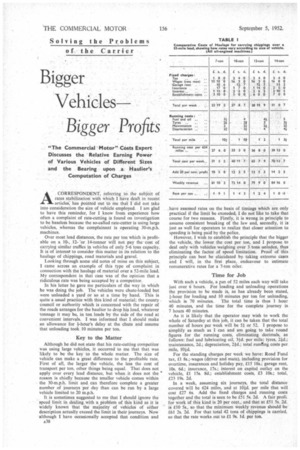Bigger Vehicles
Page 52

If you've noticed an error in this article please click here to report it so we can fix it.
Bigger Profits
"The Commercial 'Motor" Costs Expert Discusses the 'Relative Earning Power of Various Vehicles of Different Sizes and the Bearing upon a Haulier's Computation of Charges
ACORRESPONDENT, referring to the subject of rates stabilization with which I have dealt in recent articles, has pointed out to me that I did not take into consideration the size of vehicle employed. I am glad to have this reminder, for I know from experience how often a complaint of rate-cutting is found on investigation to be baseless because the so-called rate-cutter is using large vehicles, .whereas the complainant is operating 30-m.p.h. machines.
Over most lead distances, the rate per ton which is profitable on a 10-, 12'or 14-tonner will not pay the cost of carrying similar traffics in vehicles of only 5-6 tons capacity. It is of interest to consider this matter in its relation to the haulage of chippings, road materials and gravel.
Looking through some old notes of mine on this subject,
I came across an example of this type of complaint in connection with the haulage of material over a 52-mile lead. My correspondent in that case was of the opinion that a ridiculoys rate was being accepted by a competitor.
In his letter he gave me particulars of the way in which he was doing the job. The vehicles were chute-loaded but were unloaded a yard or so at a time by hand. This is quite a usual practice with this kind of material; the county council or authority which is concerned with the repair of the roads arranges for the haulier to drop his load, whatever tonnage it may be., in ton loads by the side of the road at convenient intervals. I was informed that I should make an allowance for 4-hour's delay at the chute and assume that unloading took 10 minutes per ton.
Key to the Matter Although he did not state that his rate-cutting competitor was using large vehicles, it occurred to me that that was likely to be the key to the whole matter. The size of vehicle can make a great difference to the profitable rate. First of all, the larger the vehicle, the less the cost of transport per ton, other things being equal. That does not apply over every lead distance, but when it does not the reason is chiefly because the smaller vehicle comes within the 30-m.p.h. limit and can therefore complete a greater number of journeys per day than can be run by a large vehicle limited to 20 m.p.h.
It is sometimes suggested to me that I should ignore the speed limit in dealing, with a. problem of this kind as it is widely known that the majority of vehicles of either description actually exceed the limit in their journeys. Now although I have occasionally accepted that condition and
A38 .have assessed rates on the basis of timings which are only practical if the limit be exceeded, I do not like to take that course for two reasons. Firstly, it is wrong in principle to assume consistent breaking of the law and, secondly, it is just as well for operators to realize that closer attention to speeding is being paid by the police, However, I wish to establish the principle that the bigger the vehicle, the lower the cost per ton, and I propose to deal only with vehicles weighing over 3 tons unladen, thus eliminating the factor of speed limitation. Proof of this principle can best be elucidated by taking extreme cases and I will, in the first place, endeavour to estimate remunerative rates for a 7-ton oiler.
Time for Job With such a vehicle, a run of 52 miles each way will take just over 6 hours. For loading and unloading operations the provision to be made is, as has already been stated, 1-hour for loading and 10 minutes per ton for unloading,
which is 70 minutes. The total time is thus 1 hour 40 minutes, and the time for the complete journey is 7 hours 40 minutes.
As it is likely that the operator may wish to work the whole of Saturday at this job, it can be taken that the total number of hours per week will be 51 or 52. I propose to simplify as much as I can and am going to take round figures for the running costs, eliminating decimals, as follows: fuel and lubricating oil, 31d. per mile; tyres, 21,1:1.; maintenance, 2d.; depreciation, 2fd.; total runrfing costs per mile, 1041.
For the standing charges per week we have: Road Fund tax, £1 8s.;-wages (driver and mate), including provision for overtime, insurances and holiday pay, £15 18s.; garage rent, 10s. 6d.; insurance, 17s.; interest on capital outlay on the vehicle, £1 15s. 8d.; establishment costs, £3 10s.; total, £23 19s. 2d.
In a week, assuming six journeys, the total distance covered will be 624 miles, and at 101d. per mile that will cost £27 6s. Add the fixed charges and running costs together and the total is seen to be £51 5s. 2d. A fair profit for work of this kind is 20 per cent., and that at £51 5s. 2d. is £10 Ss., so that the minimum weekly revenue should be £61 2s. 2d. For that total 42 tons of chippings is carried, so that the rate works out to fl 9s. Id. per ton.
















































































